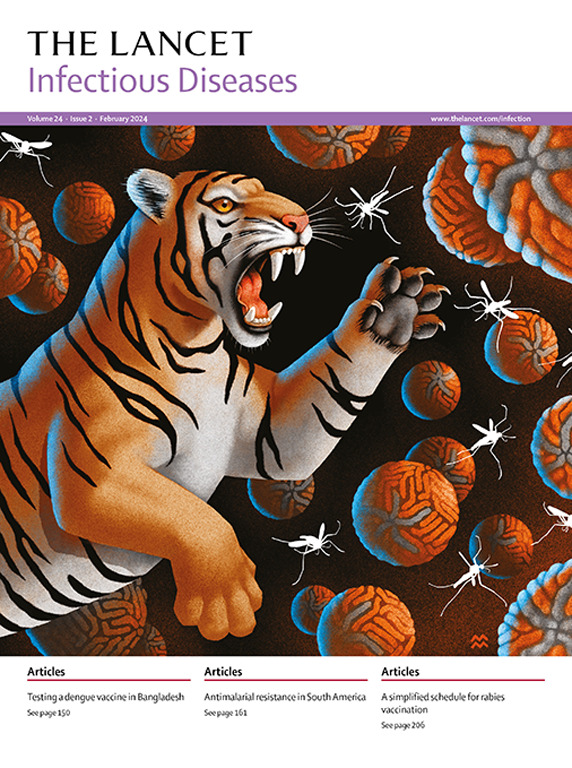Expansion of Oropouche virus in non-endemic Brazilian regions: analysis of genomic characterisation and ecological drivers
IF 31
1区 医学
Q1 INFECTIOUS DISEASES
引用次数: 0
Abstract
Background
Oropouche virus (OROV) is an arbovirus endemic in the Amazon region that closely resembles other arboviruses in terms of human disease, leading to potential misdiagnoses. The virus ecology has mostly restricted its occurrence to the Amazon biome; however, after a large 2023–24 OROV epidemic in the Brazilian Amazon region, outbreaks are being reported across Brazil and in other countries in Latin America. Here, we investigate the OROV spread outside Amazonia.Methods
In this genomic and epidemiological study, OROV cases from January, 2023, to July, 2024, provided by the General Coordination of Public Health Laboratories of Brazil on Aug 1, 2024, were compared by geographical location (Amazon vs non-Amazon) and municipal population size, and a linear mixed model was employed to assess the relationship between agricultural area size and cases. OROV-positive samples from central laboratories of five non-Amazonian Brazilian states were sequenced using an amplicon-based approach. Bayesian phylogeographical analysis was performed with near full-length viral genomes, incorporating individual travel histories when relevant. The estimated dates of viral introductions in each sampled location were then contextualised with public epidemiological data.Findings
Epidemic data show that outside the Amazon region, OROV cases frequency was 3·9-times higher in small municipalities than in large municipalities. The planted areas of some agricultural products, such as banana plantations, were positively correlated (r=0·39, p<0·0001) with OROV cases. The linear mixed model revealed that, besides banana, cassava also has larger (p<0·05) planted areas in municipalities with OROV cases when compared with those with no cases. The phylogenetic analysis of 32 new OROV genomes reconstructed multiple exportation events of the newly identified reassortant lineage from the Amazon to other Brazilian regions between January and March, 2024. At least three of the previously described OROV phylogenetic clades circulating in the Amazon were the source of viral introductions. Molecular clock analysis estimated that viral introductions happened from 50 days to 100 days before detecting the outbreaks in each state.Interpretation
Our results confirm that the novel OROV reassortant lineage spread from the Amazon to other regions in early 2024, successfully establishing local transmission. The fact that outbreaks were observed in small municipalities, instead of large urban centres, suggests that local ecological conditions that are ideal for OROV vector occurrence, such as the banana plantation environment, might be important factors driving its spread in Brazil.Funding
DECIT, CNPq, FAPEAM, and Inova-Fiocruz.Translation
For the Portuguese translation of the abstract see Supplementary Materials section.奥罗普切病毒在巴西非流行地区的扩展:基因组特征和生态驱动因素分析
背景奥罗普切病毒(OROV)是亚马逊地区流行的一种虫媒病毒,在人类疾病方面与其他虫媒病毒十分相似,可能导致误诊。该病毒的生态学特征主要限制了它在亚马逊生物群落中的出现;然而,继 2023-24 年 OROV 在巴西亚马逊地区大规模流行之后,巴西各地和拉丁美洲其他国家也陆续有疫情报告。在这项基因组学和流行病学研究中,我们按照地理位置(亚马逊地区与非亚马逊地区)和城市人口规模对巴西公共卫生实验室总协调局于 2024 年 8 月 1 日提供的 2023 年 1 月至 2024 年 7 月的 OROV 病例进行了比较,并采用线性混合模型评估了农业地区规模与病例之间的关系。采用基于扩增片段的方法对巴西五个非亚马孙地区州中心实验室的 OROV 阳性样本进行了测序。利用近全长病毒基因组进行了贝叶斯系统地理学分析,并在相关情况下纳入了个体旅行历史。研究结果流行病学数据显示,在亚马逊地区以外,小城市的 OROV 病例频率是大城市的 3-9 倍。香蕉种植园等一些农产品的种植面积与 OROV 病例呈正相关(r=0-39,p<0-0001)。线性混合模型显示,除香蕉外,木薯在有 OROV 病例的市镇的种植面积也比没有病例的市镇大(p<0-05)。通过对 32 个新的 OROV 基因组进行系统进化分析,重建了 2024 年 1 月至 3 月间新发现的再变种品系从亚马逊向巴西其他地区的多次输出事件。之前描述的在亚马逊地区流行的 OROV 系统发育支系中,至少有三个支系是病毒引入的源头。据分子钟分析估计,病毒引入发生在各州检测到疫情之前的50天至100天。 我们的研究结果证实,2024年初,新型OROV重变种系从亚马逊传播到其他地区,成功建立了本地传播。在小城市而非大城市中心观察到疫情爆发这一事实表明,香蕉种植园环境等非常适合 OROV 病媒发生的当地生态条件可能是导致其在巴西传播的重要因素。
本文章由计算机程序翻译,如有差异,请以英文原文为准。
求助全文
约1分钟内获得全文
求助全文
来源期刊

Lancet Infectious Diseases
医学-传染病学
CiteScore
60.90
自引率
0.70%
发文量
1064
审稿时长
6-12 weeks
期刊介绍:
The Lancet Infectious Diseases was launched in August, 2001, and is a lively monthly journal of original research, review, opinion, and news covering international issues relevant to clinical infectious diseases specialists worldwide.The infectious diseases journal aims to be a world-leading publication, featuring original research that advocates change or sheds light on clinical practices related to infectious diseases. The journal prioritizes articles with the potential to impact clinical practice or influence perspectives. Content covers a wide range of topics, including anti-infective therapy and immunization, bacterial, viral, fungal, and parasitic infections, emerging infectious diseases, HIV/AIDS, malaria, tuberculosis, mycobacterial infections, infection control, infectious diseases epidemiology, neglected tropical diseases, and travel medicine. Informative reviews on any subject linked to infectious diseases and human health are also welcomed.
 求助内容:
求助内容: 应助结果提醒方式:
应助结果提醒方式:


